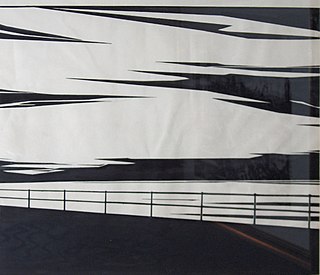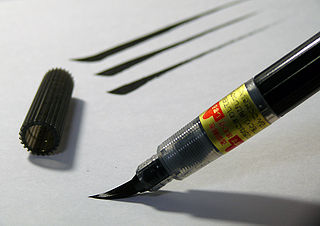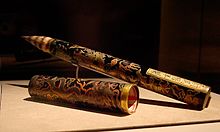
Calligraphy is a visual art related to writing. It is the design and execution of lettering with a pen, ink brush, or other writing instrument. Contemporary calligraphic practice can be defined as "the art of giving form to signs in an expressive, harmonious, and skillful manner".

A pen is a common writing instrument that applies ink to a surface, usually paper, for writing or drawing. Early pens such as reed pens, quill pens, dip pens and ruling pens held a small amount of ink on a nib or in a small void or cavity that had to be periodically recharged by dipping the tip of the pen into an inkwell. Today, such pens find only a small number of specialized uses, such as in illustration and calligraphy. Reed pens, quill pens and dip pens, which were used for writing, have been replaced by ballpoint pens, rollerball pens, fountain pens and felt or ceramic tip pens. Ruling pens, which were used for technical drawing and cartography, have been replaced by technical pens such as the Rapidograph. All of these modern pens contain internal ink reservoirs, such that they do not need to be dipped in ink while writing.

Ink wash painting ; is a type of Chinese ink brush painting which uses washes of black ink, such as that used in East Asian calligraphy, in different concentrations. It emerged during the Tang dynasty of China (618–907), and overturned earlier, more realistic techniques. It is typically monochrome, using only shades of black, with a great emphasis on virtuoso brushwork and conveying the perceived "spirit" or "essence" of a subject over direct imitation. Ink wash painting flourished from the Song dynasty in China (960–1279) onwards, as well as in Japan after it was introduced by Zen Buddhist monks in the 14th century. Some Western scholars divide Chinese painting into three periods: times of representation, times of expression, and historical Oriental art. Chinese scholars have their own views which may be different; they believe that contemporary Chinese ink wash paintings are the pluralistic continuation of multiple historical traditions.

The regular script is the newest of the Chinese script styles, popular starting from the Three Kingdoms period c. 200 CE, and stylistically mature by the 7th century. It is the most common style used in modern text. In its traditional form it is the third-most common in publishing after the Ming and Gothic types used exclusively in print.

Chinese calligraphy is the writing of Chinese characters as an art form, combining purely visual art and interpretation of the literary meaning. This type of expression has been widely practiced in China and has been generally held in high esteem across East Asia. Calligraphy is considered one of the four most-sought skills and hobbies of ancient Chinese literati, along with playing stringed musical instruments, the board game "Go", and painting. There are some general standardizations of the various styles of calligraphy in this tradition. Chinese calligraphy and ink and wash painting are closely related: they are accomplished using similar tools and techniques, and have a long history of shared artistry. Distinguishing features of Chinese painting and calligraphy include an emphasis on motion charged with dynamic life. According to Stanley-Baker, "Calligraphy is sheer life experienced through energy in motion that is registered as traces on silk or paper, with time and rhythm in shifting space its main ingredients." Calligraphy has also led to the development of many forms of art in China, including seal carving, ornate paperweights, and inkstones.

Japanese calligraphy, also called shūji (習字), is a form of calligraphy, or artistic writing, of the Japanese language. Written Japanese was originally based on Chinese characters only, but the advent of the hiragana and katakana Japanese syllabaries resulted in intrinsically Japanese calligraphy styles.

Korean calligraphy, also known as Seoye (Korean: 서예), is the Korean tradition of artistic writing. Calligraphy in Korean culture involves both Hanja and Hangul.

Huzhou is a prefecture-level city in northern Zhejiang province. Lying south of the Lake Tai, it borders Jiaxing to the east, Hangzhou to the south, and the provinces of Anhui and Jiangsu to the west and north respectively. As of the 2020 census, its population was 3,367,579 inhabitants, of whom 1,015,937 lived in the built-up area made of Wuxing District as Nanxun District is not being conurbated yet.

Gongbi is a careful realist technique in Chinese painting, the opposite of the interpretive and freely expressive xieyi style.

Four Treasures of the Study is an expression used to denote the brush, ink, paper and ink stone used in Chinese calligraphy and spread into other East Asian calligraphic traditions. The name appears to originate in the time of the Southern and Northern Dynasties.

India ink is a simple black or coloured ink once widely used for writing and printing and now more commonly used for drawing and outlining, especially when inking comic books and comic strips. India ink is also used in medical applications.

Xuan paper, Shuen paper, or rice paper, is a kind of paper originating in ancient China used for writing and painting. Xuan paper is renowned for being soft and fine-textured, suitable for conveying the artistic expression of both Chinese calligraphy and painting.

Inksticks or ink cakes are a type of solid Chinese ink used traditionally in several Chinese and East Asian art forms such as calligraphy and brush painting. Inksticks are made mainly of soot and animal glue, sometimes with incense or medicinal scents added. To make ink, the inkstick is ground against an inkstone with a small quantity of water to produce a dark liquid which is then applied with an ink brush. By adjusting the strength and duration of the ink grinding process, artists and calligraphers may adjust the concentration of the produced ink to suit their tastes.

Works of bamboo painting, usually in ink, are a recognized genre of East Asian painting. In a work of bamboo painting in ink, a skilled artist and calligrapher will paint a bamboo stalk or group of stalks with leaves. The contrast between the foreground and background, and between the varying textures represented by the stalks and the leaves, gave scope to the painter to demonstrate his or her mastery with an inkpot and a brush.

A fudepen (筆ペン), also known as a brush pen, is a cartridge-based writing implement used in East Asian calligraphy; it is, in essence, an ink brush analogue to a fountain pen.
Huzhou ink brush or Hubi is a kind of Chinese ink brush.
Xuan writing brush or Xuanbi, is a type of ink brush made in Anhui Province, China. Xuan brushes are often used and mentioned together with Xuan paper, a kind of writing rice-paper.
Daiyuexuan writing brush, is a famous brand of ink brush pens in China.
Houdian writing brush or Houdian-Maobi, is a famous kind of ink brushes in China. Along with Huzhou ink brushes, Xuan writing brushes, and Daiyuexuan writing brushes, Houdian ink brushes are among the four most famous.
Freehand brush work is a genre of Chinese traditional painting which includes poem, calligraphy, painting and seal. In Chinese called Hsieh yi, which literally means "writing ideas". It was formed in a long period of artistic activities and promoted by the literati. Through the inheritance and development in the past dynasties, freehand brush work has gradually become the most influential and popular genre.

















